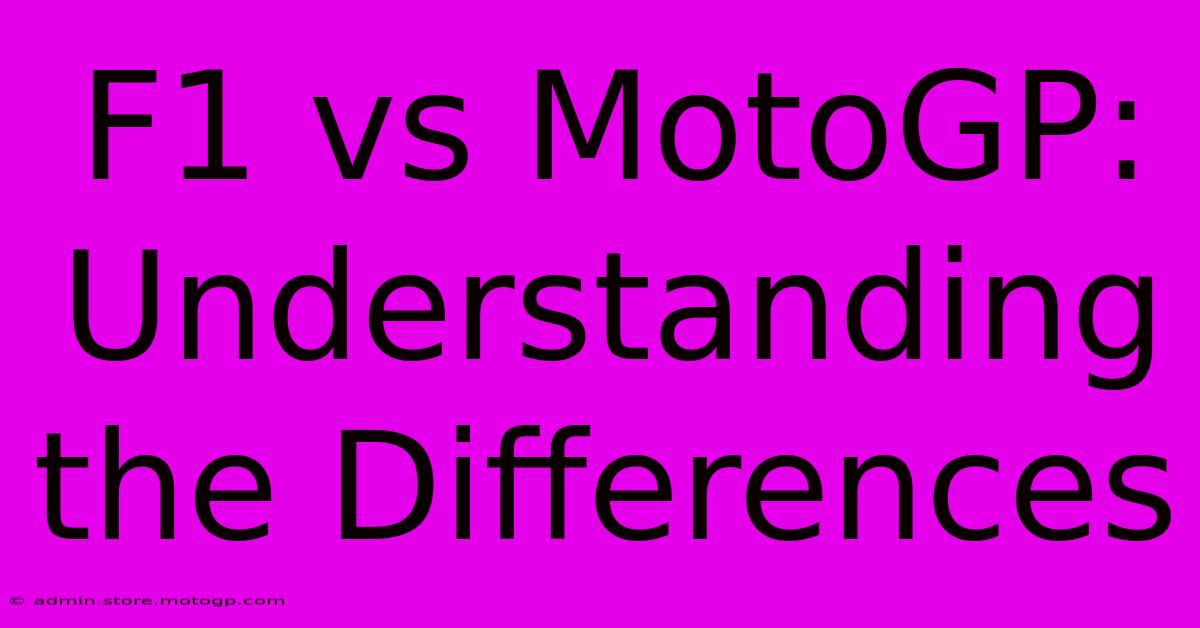F1 Vs MotoGP: Understanding The Differences

Table of Contents
F1 vs MotoGP: Understanding the Differences
For motorsport enthusiasts, Formula 1 (F1) and MotoGP represent the pinnacle of their respective disciplines. Both feature incredible speed, technological marvels, and fiercely competitive drivers and riders, but understanding the key differences is crucial to appreciating each sport's unique appeal. This article dives deep into the contrasts between these two giants of motorsports, exploring everything from the machines themselves to the racing strategies employed.
The Machines: A Tale of Two Wheels and Four
The most obvious difference lies in the vehicles themselves. F1 cars are sophisticated single-seater, four-wheeled machines, powered by complex 1.6-liter turbocharged hybrid V6 engines. These cars generate immense downforce, allowing them to corner at breathtaking speeds. Their technology is cutting-edge, constantly pushing the boundaries of aerodynamics, materials science, and engine performance. Think of them as highly tuned, technologically advanced race cars built for speed and precision on circuits.
MotoGP bikes, on the other hand, are two-wheeled beasts, powered by powerful prototype engines that are typically 1000cc. While also incredibly advanced, they rely less on aerodynamic downforce and more on rider skill and precision. The balance and control required to ride a MotoGP bike at its limits is arguably even more challenging than driving an F1 car. These are sophisticated, high-powered motorcycles demanding immense physical and mental fortitude.
Engine Technology: A Contrast in Approaches
The engine technology highlights a fundamental difference in philosophy. F1 engines are complex hybrid systems, prioritizing fuel efficiency alongside power. The regulations constantly evolve, pushing teams to innovate and find marginal gains in both performance and efficiency. This leads to a constant arms race in terms of engine development and technology.
MotoGP engines, while also highly advanced, focus more on raw power and torque delivery. While fuel efficiency is a consideration, the emphasis is on delivering maximum power to the rear wheel, requiring exceptional rider skill to manage.
The Racing: Strategy and Skill
The racing itself presents another set of key distinctions. F1 races are typically longer, lasting around two hours, and involve more strategic elements like tire management, pit stops, and race strategy. Teams have dedicated strategists who analyze data and make crucial decisions during the race.
MotoGP races are shorter, generally lasting around 45 minutes, and rely more on the raw skill and reflexes of the riders. Overtaking maneuvers are more frequent and require precise bike handling and daring. While strategy still plays a role, the emphasis is more on individual rider performance and ability to manage the bike throughout the race.
The Human Element: Driver vs. Rider
While both F1 drivers and MotoGP riders require immense skill, the demands on the human body differ significantly. F1 drivers experience high G-forces during cornering, but it's a more controlled and supported environment within the cockpit.
MotoGP riders experience far greater exposure to the elements and must contend with the constantly shifting balance of the bike. The physical exertion involved is immense, demanding incredible strength, stamina, and balance. They are constantly battling the bike's weight and momentum.
The Spectators' Experience: A Different Kind of Thrill
The spectator experience also offers contrasting thrills. F1 races are known for their strategic depth and the spectacle of high-speed cornering and overtaking. The technological marvels of the cars are readily apparent.
MotoGP races are characterized by the raw power, thrilling close racing, and the incredible skill of the riders. The visceral excitement of watching motorcycles lean into corners at unbelievable speeds is unparalleled.
Conclusion: Two Sides of the Same Coin
F1 and MotoGP, while both motorsport giants, offer vastly different experiences. One emphasizes technological superiority and strategic depth, the other showcases raw power and exceptional rider skill. Ultimately, the "better" sport is a matter of personal preference. Both disciplines deserve appreciation for their contribution to the world of motorsports and their ongoing evolution. Choosing a favorite depends entirely on what kind of racing thrills you most enjoy.

Thank you for visiting our website wich cover about F1 Vs MotoGP: Understanding The Differences. We hope the information provided has been useful to you. Feel free to contact us if you have any questions or need further assistance. See you next time and dont miss to bookmark.
Featured Posts
-
Moto Gp Race Tracks Speed Skill And Strategy
Feb 19, 2025
-
Moto Gp Starting Grid Understanding Grid Penalties
Feb 19, 2025
-
From Paddock To Podium Your Formula 1 Austin Map
Feb 19, 2025
-
Motorcycle Race Bikes For Sale Built To Impress
Feb 19, 2025
-
Moto Gp Streams Get Ready For The Ultimate Adrenaline Rush
Feb 19, 2025
